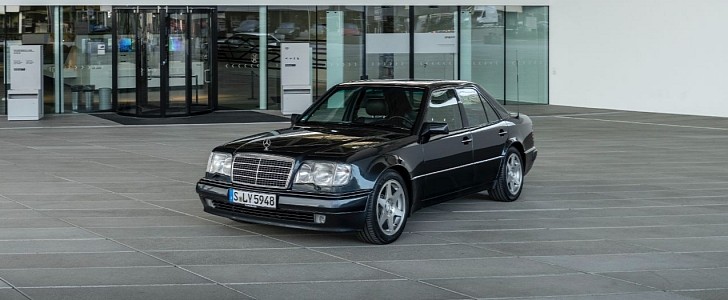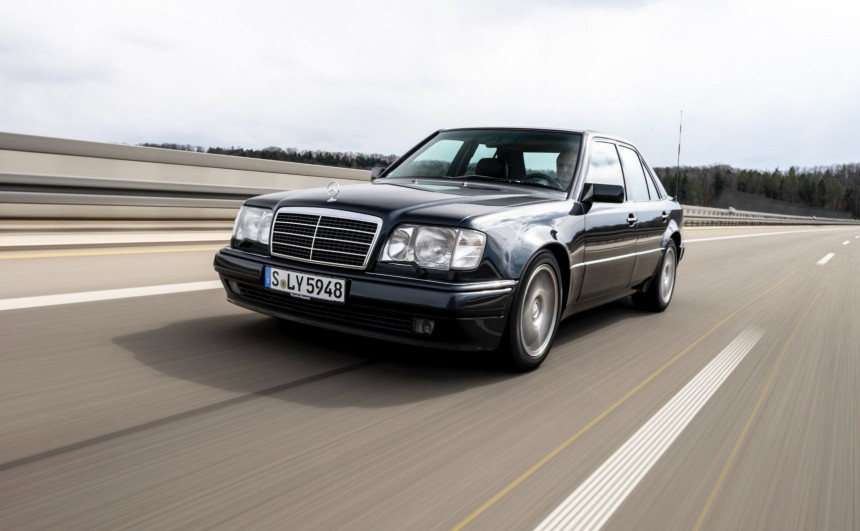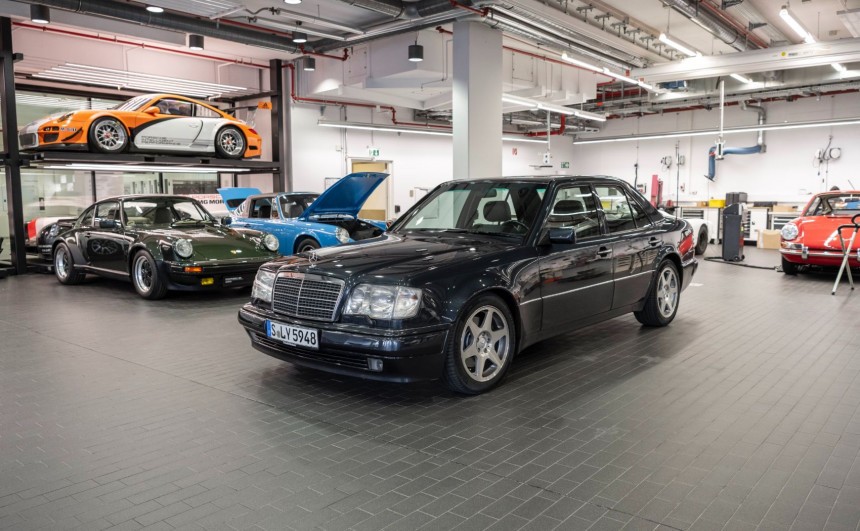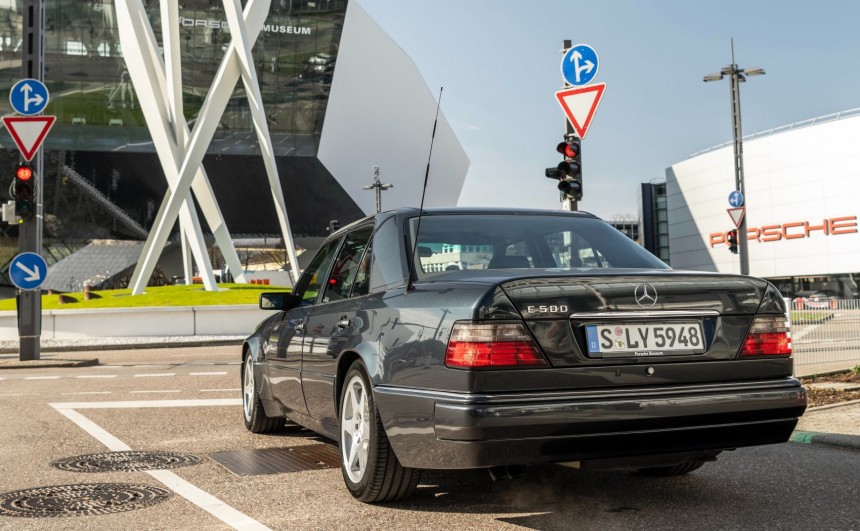To the untrained eye, it looked just like a standard E-Class, but the 500 E was a rabid version of the popular mid-size sedan from the 80s and 90s. Developed, assembled, and fine-tuned by Porsche, the V8-powered wolf in sheep’s clothing was capable of shaming many sports cars of the era, becoming one of the coolest factory sleepers ever built.
In 1988, Porsche was contracted by cross-town rivals Daimler-Benz to design and develop an experimental version of the W124 series. At the time, Mercedes engineers had their hands full with the development of the new S-Class flagship while the Zuffenhausen-based carmaker was struggling due to a drop in sales, so the partnership made perfect sense for both parties.
The plan was simple and extremely German: turn the earthly sedan into a high-performance beast by equipping it with a 5.0-liter V8 without spending too much time or money on unnecessary visual enhancements. However, converting the vehicle without major visual alterations was no easy task.
Porsche’s team started with chassis modifications widening it by about 2 inches (5 cm) to accommodate the revamped suspension system, which also lowered the car by almost an inch (2.5 cm). They then completely overhauled the engine bay to make room for the massive eight-cylinder. Even the battery was relocated to the trunk to maximize space and improve weight distribution.
During the prototype phase, engineers discovered that the naturally aspirated powerplant was not receiving enough air. Rather than redesigning the front grille or fitting vents on the hood, they opted for an innovative workaround: they widened the gap surrounding the two headlights, which helped deliver the optimum amount of air. The only modifications made to the bodywork were enlarged wheel wells, along with subtly redesigned bumpers.
Inside, it featured four sport seats provided by Recaro and was only available as a four-seater because the large rear differential made it impossible to equip it with a standard bench seat.
The powertrain, which included the potent M119 V8 and a four-speed automatic transmission, was sourced from the 500 SL roadster. However, the engine incorporated several distinct modifications, such as shorter con rods or a newly developed crankcase. In addition, a partially-mechanic Bosch injection system was replaced by a fully electronic version.
These modifications resulted in an output of 322 hp (240 kW/326 PS) and 347 lb-ft (480 Nm) of torque, enabling the 500 E to sprint from 0 to 62 mph (100 kph) in 6.1 seconds, only one-third of a second more than a 1984–1991 Ferrari Testarossa. Because no extensive aerodynamic improvements were made, the top speed was limited to 155 mph (250 kph).
The Mercedes-Benz 500 E debuted at the 1990 Paris Motor Show, with production and customer deliveries commencing a year later. Every chassis was hand-assembled at Porsche’s Reutter plant, then shipped to Daimler’s Sindelfingen plant to be painted. As crazy as it may sound, the varnished chassis made its way back to Zuffenhausen for engine assembly and got shipped to Sindelfingen yet again for final inspection and delivery. The entire process took 18 days per car, and we can only imagine how much more it would have taken if the two plants weren’t located a few miles away.
With minor modifications throughout the years, this outrageous sedan was built until April 1995 in only 10,479 units.
Today, this modern classic is highly appreciated by Mercedes enthusiasts, being considered one of the most impressive performance-oriented models that weren’t built, developed, or tuned by AMG. It’s also the ultimate factory-built sleeper, and with a few minor modifications, gearheads managed to push the V8 well over the 400-hp mark, shocking many sports car owners by whizzing past them on the Autobahn.
Recently, Porsche celebrated 30 years since sales of the car began by inviting two key members of the 1990 development team to take a 500 E for a spin on a 62-mile (100 km) route that started and ended in front of the Porsche Museum. Both Michael Hölscher, development project manager at the time, and Michael Mönig, a member of the prototype management team, had a blast driving around in the epic Mercedes they helped build as Porsche employees.
The unusual story of this amazing car proves that great things can be achieved when rivals put away their differences and decide to work together.
The plan was simple and extremely German: turn the earthly sedan into a high-performance beast by equipping it with a 5.0-liter V8 without spending too much time or money on unnecessary visual enhancements. However, converting the vehicle without major visual alterations was no easy task.
Porsche’s team started with chassis modifications widening it by about 2 inches (5 cm) to accommodate the revamped suspension system, which also lowered the car by almost an inch (2.5 cm). They then completely overhauled the engine bay to make room for the massive eight-cylinder. Even the battery was relocated to the trunk to maximize space and improve weight distribution.
Inside, it featured four sport seats provided by Recaro and was only available as a four-seater because the large rear differential made it impossible to equip it with a standard bench seat.
The powertrain, which included the potent M119 V8 and a four-speed automatic transmission, was sourced from the 500 SL roadster. However, the engine incorporated several distinct modifications, such as shorter con rods or a newly developed crankcase. In addition, a partially-mechanic Bosch injection system was replaced by a fully electronic version.
The Mercedes-Benz 500 E debuted at the 1990 Paris Motor Show, with production and customer deliveries commencing a year later. Every chassis was hand-assembled at Porsche’s Reutter plant, then shipped to Daimler’s Sindelfingen plant to be painted. As crazy as it may sound, the varnished chassis made its way back to Zuffenhausen for engine assembly and got shipped to Sindelfingen yet again for final inspection and delivery. The entire process took 18 days per car, and we can only imagine how much more it would have taken if the two plants weren’t located a few miles away.
With minor modifications throughout the years, this outrageous sedan was built until April 1995 in only 10,479 units.
Recently, Porsche celebrated 30 years since sales of the car began by inviting two key members of the 1990 development team to take a 500 E for a spin on a 62-mile (100 km) route that started and ended in front of the Porsche Museum. Both Michael Hölscher, development project manager at the time, and Michael Mönig, a member of the prototype management team, had a blast driving around in the epic Mercedes they helped build as Porsche employees.
The unusual story of this amazing car proves that great things can be achieved when rivals put away their differences and decide to work together.

















